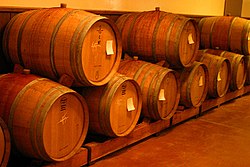Barrel
Barrel is an old English word for a big holder of liquids, such as petrol, beer, wine or oil. Barrels are most commonly made of either wood or metal but many are plastic
Barrels are used to age wine, and other beverages such as whisky and beer. Most of those are made of oak wood.
A barrel is also used to measure liquids. One barrel of oil is 158.987 litres (42 US gallons). It is shortened as "bbl". This use may have come from the early Pennsylvanian oil fields where wooden barrels were used to store and move oil around. In 1866, the people of West Virginia started using it regularly. At this time, the amount was set to 42 American gallons. It was later world-wide for measuring amounts of oil and pricing it. Today, oil is rarely stored or transported in actual barrels, but the term "barrel" is still used to mean a 42-gallon measurement.
A barrel can also be used to measure dry goods. For example, a barrel can mean 196 pounds (about 89 kilograms) of flour.
Different sizes
The size of some standard barrels is not the same in all countries. Some countries have different sizes for different liquids.
- In the United Kingdom, there is a standard barrel for beer. It is 36 imperial gallons (163.659 litres).
- In the United States, a standard barrel for liquids is 31.5 US gallons (about 119.2 litres). For beer, the standard barrel is 31 US gallons (117.348 litres), because of tax laws.
- A physical metal barrel for oil or chemicals usually holds 55 US gallons (208.198 litres), but the word "barrel" used as a measurement refers to a 42-gallon measurement.
History
The first people to start using barrels were the Celts about 350 BC. The Roman Empire started using barrels after trading with the Celts. Barrels remained popular for shipping items until the 20th century.
Barrel Media
Mackmyra barrels at Häckeberga Castle
Modern stainless steel casks and kegs outside the Castle Rock microbrewery in Nottingham, England
Wooden wine barrel at an exhibition in Croatia
Pyramidal pile of herring barrels in Scheveningen, the Netherlands, c. 1940
This Mercier oak barrel with a capacity of 200,000 Champagne bottles was created for the 1889 world exposition in Paris.
Sherry barrel with glass barrel head to show the layer of flor floating atop the aging wine
Charred white oak barrels are filled with new bourbon whiskey and resting in a rack house for a period of typically 4 to 9 years (for good-quality bourbon), with the char giving the bourbon its characteristic copper color.
| Wikimedia Commons has media related to Lua error in Module:Commons_link at line 62: attempt to index field 'wikibase' (a nil value).. |










